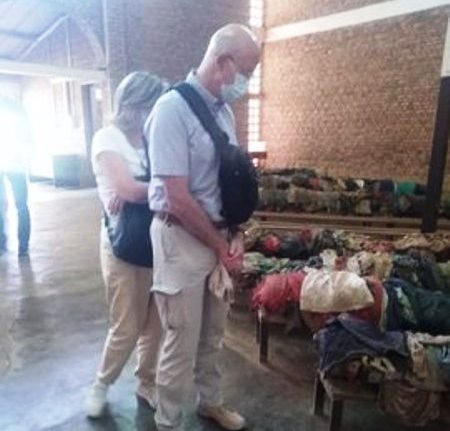
Today, Colonel Didier Calmant, Defence attaché at the embassy of Belgium in Rwanda visited Nyamata genocide memorial and paid respect to the victims laid to rest at the memorial.
He was also taken to a guided tour of the memorial’s exhibits and provided with explanations about the genocide in Nyamata.
Before concluding his visit at Nyamata genocide memorial, Colonel Didier Calmant left a heartfelt message in the guest book.
“It is with upmost respect that we paid a visit to this site of memory for the genocide against the Tutsis. Thank you for helping the memories alive”, Colonel Didier Calmant wrote.
Nyamata Genocide memorial is one of the four sites that Rwanda has embarked on the project to list on the UNESCO world heritage List. It is the final rest place to more than 45000 victims of the Genocide against the Tutsi.
The 1994 Genocide in Nyamata
Following the assassination of President Habyarimana on 6th April 1994, the Genocide commenced in Bugesera almost immediately. On 7thApril, extremists started burning down Tutsi houses in Nyamata, but as there were many Tutsi in this area they tried to defend themselves. By 11th April many Tutsi had left their homes and gathered within the grounds of Nyamata Primary School. Women and children had taken refuge in the church, while others were at the Centre d’Enseignement rural et Artisanal Integré (CERAI) Nyamata.
Killings began at CERAI on the morning of 11th April using similar tactics to those implemented in other parts of Rwanda. They first surrounded the area where the Tutsis had gathered, threw grenades into crowds and then fired at them with fire guns. They then sprayed capsicum over the dead bodies to check if anyone was still alive so they could killed them with machetes.
Claire Nkima, a survivor of the CERAI killings says that survivors of the attack made plans to escape to Gitarama or Burundi, but most did not escape because the killers had established roadblocks to finish their work.
Between the 14th and 16thApril, approximately 5,000 Tutsi were killed inside Nyamata Church. Of the few that escaped from the church, they took refuge in nearby bushes and papyrus fields, but later many were found and killed by militia search parties until the RPF Inkotanyi finally liberated Bugesera.
Nyamata Genocide memorial
Most of the Tutsi population living mostly in north and south of the country were forcibly deported to dwell into the barren and tsetse fly infected area of Nyamata.
Once the area operated and become habitable by these occupants Tutsi in 1980, a church was setup for worship. In 1994, this place once regarded holy and sacred become desecrated; a place of sacrifice of the Tutsi faithful members by their Rwandan counterparts where over forty five thousand people who had sought refuge were all brutally massacred in one day.
After negotiations between the Catholic Church and the Rwandan government, the church was converted into a memorial site, representing other churches in which the victims of the genocide against the Tutsi were slaughtered.
The memorial is composed of a chapel in which victims’ clothes are displayed, along with the weapons used to kill them. Beneath the chapel there is a room displaying the remains of those killed in the church. Mass graves are situated behind the church, with a vault that houses the skulls of victims and other human remains.
In addition, the memorial site includes the grave of Antonia Locatelli, an Italian with a placard explaining her life and work in Rwanda, and her eventual murder on the 9th March 1992 after she denounced to Radio France Internationale (RFI) and Radio BBC the role of the Government in the killings targeting the Tutsi in Bugesera, which claimed more than 500 victims in one week. (End)
